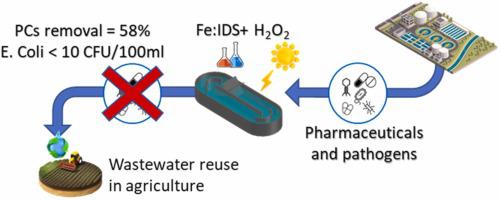Journal of Hazardous Materials ( IF 12.2 ) Pub Date : 2023-03-20 , DOI: 10.1016/j.jhazmat.2023.131235 Pellegrino La Manna 1 , Marco De Carluccio 1 , Patrizia Iannece 2 , Giovanni Vigliotta 2 , Antonio Proto 3 , Luigi Rizzo 1

|
In this work, Fe3+-iminodisuccinic acid (Fe:IDS) based solar photo Fenton (SPF), an Italian patented method, was investigated in quaternary treatment of real urban wastewater and compared to Fe3+-ethylenediamine-N,N′-disuccinic acid (Fe:EDDS) for the first time. Three pharmaceuticals (PCs) (sulfamethoxazole, carbamazepine and trimethoprim) and four pathogens (Escherichia coli, somatic and F-plus coliphages, Clostridium perfringens, consistently with the new EU regulation for wastewater reuse (2020/741)), were chosen as target pollutants. SPF with Fe:EDDS was more effective in PCs removal (80%, 10 kJ L−1) than the SPF with Fe:IDS (58%), possibly due to the higher capability of generating hydroxyl radicals. On the contrary, Fe:IDS was more effective (4.3 log inactivation for E. coli) than Fe:EDDS (1.9 log) in pathogens inactivation, possibly due to a lower iron precipitation and turbidity which finally promoted an improved intracellular photo-Fenton mechanism. Fe:L based SPF was subsequently coupled to sunlight/H2O2. Interestingly, while its combination with Fe:EDDS based SPF slightly increased disinfectant efficacy (2.3 vs 1.9 log inactivation for E. coli), the combination with Fe:IDS decreased inactivation efficiency (3.4 vs 4.3 log reduction). In conclusion, due to the good compromise between PCs removal and disinfection efficiency, Fe:IDS SPF alone is an attractive option for quaternary treatment for urban wastewater reuse.
中文翻译:

螯合剂支持太阳光芬顿和阳光/H2O2 过程,用于城市废水再利用的四元处理中的药物去除和耐药病原体灭活
在这项工作中,研究了基于意大利专利方法 Fe 3+ -亚氨基二琥珀酸 (Fe:IDS) 的太阳光芬顿 (SPF) 在实际城市废水的四元处理中的应用,并与 Fe 3+ -乙二胺-N,N'进行了比较- 首次发现二琥珀酸 (Fe:EDDS)。三种药物 (PC)(磺胺甲恶唑、卡马西平和甲氧苄氨嘧啶)和四种病原体(大肠杆菌、体细胞和 F-plus 大肠杆菌噬菌体、产气荚膜梭菌,符合欧盟关于废水再利用的新法规 (2020/741))被选为目标污染物. 具有 Fe:EDDS 的 SPF 在去除 PC 方面更有效(80%,10 kJ L -1) 比具有 Fe:IDS (58%) 的 SPF,可能是由于产生羟基自由基的能力更高。相反,Fe:IDS在病原体灭活方面比 Fe:EDDS (1.9 log) 更有效(大肠杆菌 4.3 log 灭活),这可能是由于较低的铁沉淀和浊度最终促进了细胞内光芬顿机制的改善. 基于 Fe:L 的 SPF 随后与阳光/H 2 O 2偶联。有趣的是,虽然它与基于 Fe:EDDS 的 SPF 的组合略微提高了消毒效果(大肠杆菌的2.3 对 1.9 对数灭活),与 Fe:IDS 的组合降低了灭活效率(3.4 对 4.3 对数减少)。总之,由于 PCs 去除和消毒效率之间的良好折衷,单独使用 Fe:IDS SPF 是城市废水再利用的四元处理的一个有吸引力的选择。











































 京公网安备 11010802027423号
京公网安备 11010802027423号